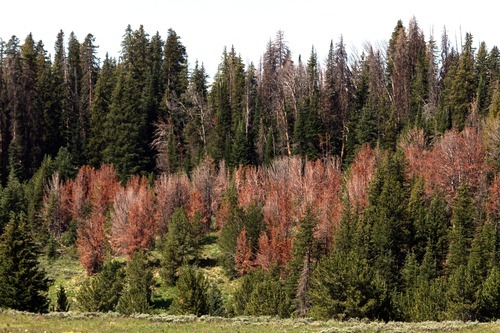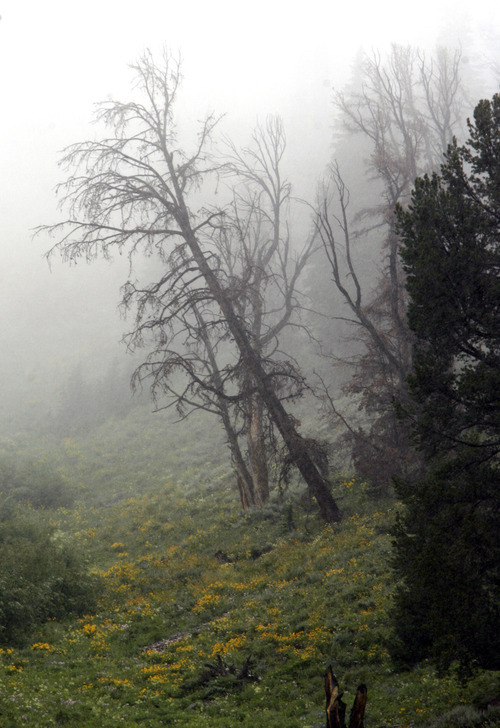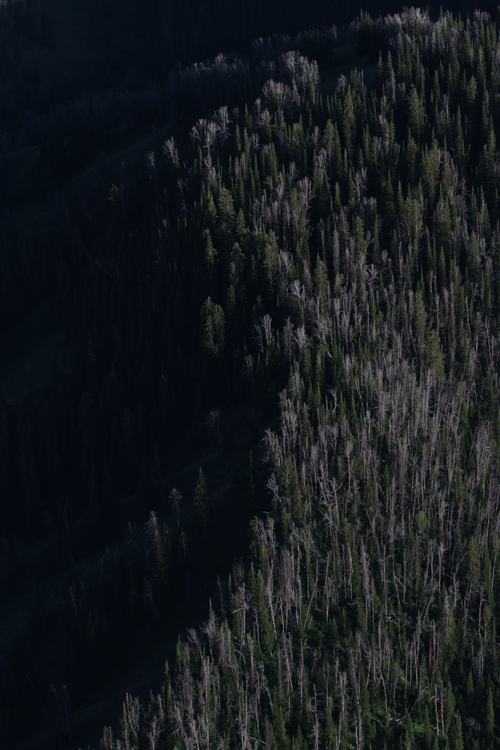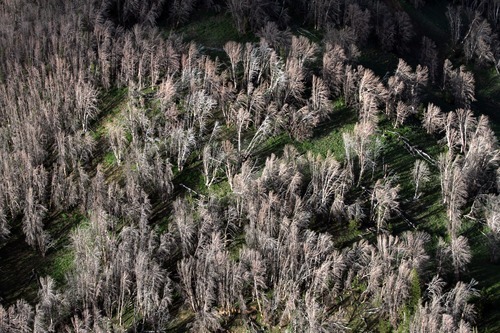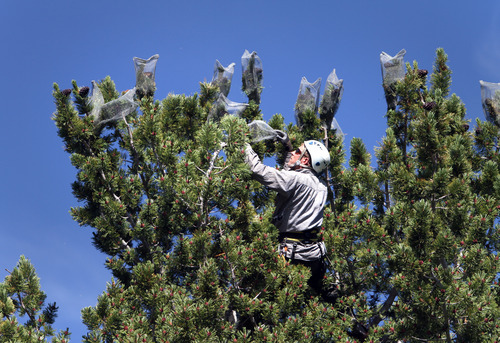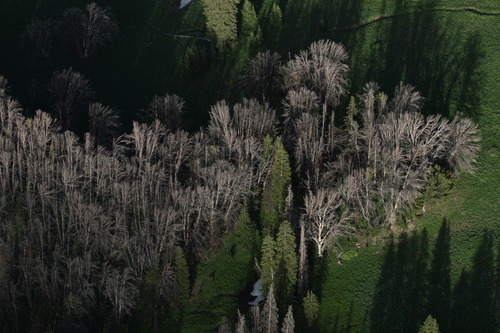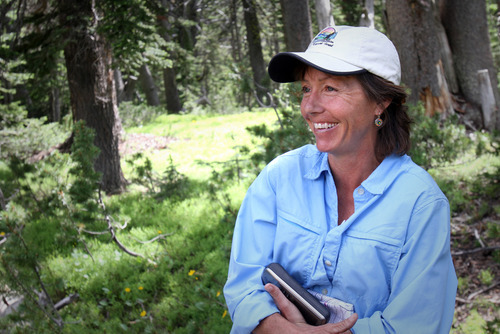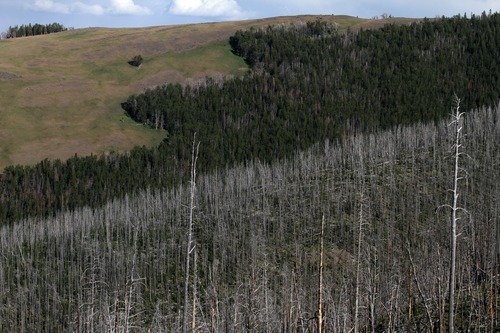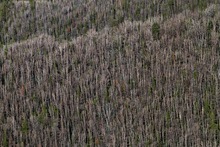This is an archived article that was published on sltrib.com in 2011, and information in the article may be outdated. It is provided only for personal research purposes and may not be reprinted.
Togwotee Pass, Wyo. • Eric "Doc" Janssen dangles above the continent, roped to the crown of a centuries-old tree and cradling to his chest the future of a species and, perhaps, America's most revered outdoor playground.
The whitebark pine is dying, quickly, from Yellowstone's ecosystem and the Northern Rockies. Alarmed conservationists and scientists fear it's tearing the ecological heart from the world's first national park. Even the great bear, the closest thing to a Yellowstone mascot and a voracious scrounger of pine nuts, is at risk.
The U.S. Fish and Wildlife Service this summer ruled that the tree is worthy of the endangered-species list — the government just doesn't have money to list and fully protect it.
But Janssen, a permanent seasonal biological technician with Grand Teton National Park, is perched in the craggy tuft of green needles 50 feet above an alpine meadow several mountains south of Yellowstone, midwifing. He slips wire mesh bags over pine cones, saving them from their rightful owners and distributors — squirrels and jays — so they can ripen and be collected later for a seed bank in Colorado Springs.
Other days he snips tiny limb tips for grafting at nurseries. Or he tacks up pheromone pouches that send chemical signals that burrowing mountain pine beetles aren't welcome.
It's not much, but it's something.
"Sometimes we struggle emotionally with whether what we're doing matches the scale of what's going on," says Teton park ecologist Nancy Bockino. "You gotta try."
All around her are hillsides of red and gray death, a haunting welcome for RV tourists who crest this pass and then catch their first glimpse of the towering granite Tetons. This part of the Bridger-Teton National Forest is just one hot spot for beetles and a European tree disease, which are ravaging the old pines throughout the Maine-sized ecosystem anchored by Old Faithful.
Rappelling down after caging 25 fruitcake-hard purple cones, Janssen confesses his affection for individual trees — those that survive and those he couldn't save.
The whitebark is a distinctive evergreen, twisting through deep snow and cold winds in its youth, then stretching warped limbs skyward, offering cones to cackling gray Clark's nutcrackers on a hedge-flat top. Its botanical personality will never be mistaken for a Christmas tree.
"You do get pretty attached to trees," Janssen says, "especially the ones you've climbed."
The beetles crawling under the bark are a different story. Curious, sure, and with their natural role to play in recycling forests. But most scientists who are watching these trees die think the warming climate is helping beetles thrive on mountaintops where they once couldn't.
Some think the forest will recover like it always has. Some expect "functional extinction" within a decade, leaving a few trees but not enough to feed grizzly bears or to shade late-melting snowbanks that cool summer trout streams or to create the micro-climates that allow berries and rodents to thrive on otherwise dry peaks.
Bockino and Janssen are somewhere in between, buying time for what they hope will be a resurgence.
"[Beetles] did co-evolve with these trees," Janssen says. "I don't know who's to say this isn't what's supposed to happen. It's just so in-your-face. As a human, you think, 'Oh my God. They're all dead.' "
Not all of them, of course, unless you're standing on one of many newly gray slopes lining the Gros Ventre Mountains east of Jackson Hole or the Gravelly Range beyond West Yellowstone. But enough to suddenly propel an isolated, commercially insignificant species into a frenzy of research and politics.
An interagency team that tagged nearly 5,000 trees across the ecosystem in 2004-2007 returned in 2008-2010 to find about a sixth of those whitebarks freshly killed. More troubling, two-thirds of the larger trees — the seed producers — were gone. Presumably, if the beetles keep coming as they have for more than a decade, they will eventually settle for the less-succulent small trees.
Those results followed a 2009 report by Logan-based geospatial analyst Wally MacFarlane of Geo/Graphics, which startled scientists. Working with a retired Forest Service researcher and the Natural Resources Defense Council, MacFarlane found freshly killed trees in nearly every stream drainage. Half the zones had suffered extreme mortality, losing up to 95 percent of their seed trees. And thosenumbers have grown during the past two years.
Elsewhere in the trees' Northern Rockies range, an interagency work group found 90 percent mortality.
"It's not just these spot outbreaks" of the past MacFarlane says, "but a coalesced occurrence that dominates the landscape."
From the air, the low mountains east of Jackson Hole are a sea of gentle gray waves, the whitebarks fully obliterated slope after slope, naked limbs stretched to the heavens. In the valleys between them are periodic geometrically plotted green patches — young, resilient lodgepole pines, reviving from 1970s clear cutting, says pilot Mike Collins.
Collins has been flying here that long, frequently accompanying nature photographers and wildlife-tracking biologists. He believes the old logging, which caused "a lot of squawking" among the resort area's nature lovers, has proven essential because beetles won't take scrawny young trees.
"Some of these areas," he says, "are gonna be the saving grace of the forest."
Whitebark, though, isn't for loggers. The tree is generally in rocky terrain too far from valley roads and too gnarled to make good lumber.
Beetles are the big killers here, but farther north, in wetter areas of Idaho or in Montana's Glacier National Park, nonnative blister rust spores have nearly wiped out whitebarks.
The crash led Fish and Wildlife Service biologists to agree the tree merits protection under the Endangered Species Act. The agency will conduct a second review next year to either confirm or elevate the whitebark's priority status.
Wyoming-based Fish and Wildlife biologist Amy Nicholas says the July ruling followed research confirming a threat from warming winters, which allow beetles to survive on the peaks where whitebarks live.
The Utah Climate Center says data from a Moose, Wyo., weather station in Grand Teton National Park indicate average winter lows have warmed by less than half a degree per decade since 1970. But those averages reflect a decline of extreme subzero cold snaps, which would be expected to kill beetle larvae.
The crisis has jump-started research meant to protect the whitebark, including a "plus tree" program in which foresters and scientists identify healthy trees and an Idaho nursery propagates and tests them to ensure disease-resistance.
Biologists also are scrambling to see whether thinning trees around whitebarks will help.
Last month, Gallatin National Forest biologist Jodie Canfield hiked through thickly forested slopes around an old mining district at Cooke City, Mont., just outside Yellowstone. She was marking points for a thinning experiment in a place that has resisted beetles, perhaps because it's buffered by the high, cold Beartooth Plateau.
In October, she will tap about $20,000 in grants to pay a fire crew to cut fir and other trees, which are shading whitebark pines, to see how they respond. Then she will pay a University of Idaho researcher $10,000 to come back in three and five years to record the results.
"It's just been in the last five years there's been any money for whitebark [research]," she says.
This scientific scurry is good news to Louisa Willcox, Yellowstone-area senior wildlife advocate for the Natural Resources Defense Council. She just hopes it's not too late for the grizzlies.
The Yellowstone bears, which have expanded their range and tripled their numbers to about 600 since their own federal protection in the 1970s, are starting to confront failing pine-nut crops.
Bear-human conflicts, ending in death for the grizzlies frequently and people rarely, increase in years of poor whitebark seed production, according to the U.S. Geological Survey-led Interagency Grizzly Bear Study Team. Hungry bears go looking for food, sometimes in camps or the gut piles that elk hunters leave behind.
All-time highs — approaching 50 bear deaths — have been recorded in the past few years.
Government research shows bear litter sizes also dip in bad years, from 2.2 to 2 — fewer triplets, but still more twins than singles.
"There is overwhelming scientific evidence," Willcox says, "that shows the greater Yellowstone ecosystem whitebark pine is a key driver of this population."
Study team leader Chuck Schwartz says it isn't so simple. Even in years of lackluster seed crops, researchers have found, during the past 26 years, deaths to females exceed what scientists consider acceptable about a quarter of the time.
Sampling of bear hairs shows scientists that grizzlies eat more meat when whitebark declines. Maybe they kill elk calves. Maybe they dig pocket gophers.
"Grizzly bears are opportunistic omnivores," Schwartz says. "They take advantage of whatever the best food is available at that time of year, and they diet-switch."
Environmentalists are struggling in court to maintain the bears' protection, citing the trees' decline. The government has declared the bears recovered, but a federal judge disagreed. The ruling is on appeal.
The government's position, Willcox says, "is a little bit surprising, given that the landscape has been turned upside down."
Yellowstone officials say they are seeing some young whitebark pines grow where the old trees have died. Their mission is to encourage natural processes, and so far they believe that's working.
Foresters have predicted the demise of whitebark before, park ecologist Roy Renkin says, recalling Dust Bowl-era journals lamenting a beetle outbreak. And people seem to forget an infestation that wiped out limber pine, a related species, around park headquarters in the mid-1980s.
"It looked like this [1980s] outbreak was going to decimate the forest," Renkin says, "but all of a sudden the outbreak crashed."
Those 20th-century outbreaks were nothing compared with this one, according to MacFarlane, the aerial mapper. If they were, his crew would have found many slowly decaying tree trunks among the fresh dead that they surveyed. Instead, they found "legacy" trees in only 9 percent of the plots.
Others say the regeneration that Yellowstone reports is from pre-outbreak seeds, and there aren't seed producers left to continue it.
In fact, the whitebark's plight is almost a lost cause for some scientists.
Diana Six, a University of Montana entomologist who specializes in bark beetles, says Yellowstone once appeared a crucial refuge for whitebark because its cold, dry mountains wouldn't support blister rust so well. Central Idaho was warmer and, consequently, had lost 98 percent of its whitebarks.
Then the mountain winters warmed and beetles flowed uphill.
"Now," she says, "with the beetle [in Yellowstone], whitebark just seems like it's toast. Nothing's going to shove the beetle off the mountain now."
Bockino, the Grand Teton ecologist, keeps the faith. Unlike her Yellowstone counterparts, who prefer to watch the trends, she spends almost every working day of the summer in the trees, trying to save them. Next year she'll plant seedlings in the park.
Beetles have hit the Tetons' east slope hard, she says, and it shows along popular trails such as Garnet Canyon. She thinks the trees deserve some help against native beetles because they also face the nonnative blister rust. It's crucial to save pockets of seed growers.
"We saved 200 trees in Garnet Canyon," she says. "If they live 500 years more, how many cones will they produce?"
Enough to outlast beetles and fight through climate change? Enough to place the gnarly, slow-growing crown back on these mountains?
Only the centuries will tell.




